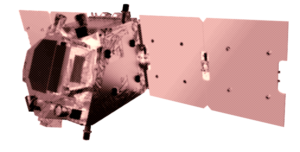The coatings for the space research
A PROJECT WITH CNR AND ESA

In
2025
2025
2025
the European Space Agency will launch in orbit Flex.
The satellite will communicate with a topcoat,
created inside Renner laboratories,
to monitor the health condition
of the plant life worldwide.
The coatings for the space research
A PROJECT WITH CNR AND ESA

In
2025
the European Space Agency will launch in orbit Flex.
The satellite will communicate with a topcoat,
created inside Renner laboratories,
to monitor the health condition
of the plant life worldwide.
The satellite will communicate with a topcoat,
created inside Renner laboratories,
to monitor the health condition
of the plant life worldwide.

or the 50th anniversary of the landing on the Moon, ESA’s Earth Explorer eighth mission involves Renner Italia and the National Research Council (CNR – Consiglio Nazionale delle Ricerche).
Flex, acronym of Fluorescence Explorer, is ESA’s satellite to be launched in orbit in 2025 to monitor the health of the forests. It will be equipped with a tool, able to map the fluorescence of the plant life in the spectral domain between 500 and 880 nanometres, detecting the light emitted by the plants. Flex will systematically check-up the tenuous reddish brilliance emitted by the plants during photosynthesis, at 815 km from the Earth. The plants fluorescence, which is invisible to the human eye, is an extraordinary diagnostic tool, able to calculate the photosynthesis activity of the Earth’s systems and to diagnose the plant life stress.

or the 50th anniversary of the landing on the Moon, ESA’s Earth Explorer eighth mission involves Renner Italia and the National Research Council (CNR – Consiglio Nazionale delle Ricerche).
Flex, acronym of Fluorescence Explorer, is ESA’s satellite to be launched in orbit in 2025 to monitor the health of the forests. It will be equipped with a tool, able to map the fluorescence of the plant life in the spectral domain between 500 and 880 nanometres, detecting the light emitted by the plants. Flex will systematically check-up the tenuous reddish brilliance emitted by the plants during photosynthesis, at 815 km from the Earth. The plants fluorescence, which is invisible to the human eye, is an extraordinary diagnostic tool, able to calculate the photosynthesis activity of the Earth’s systems and to diagnose the plant life stress.
Global changes

he greenhouse gases emissions cause a speed climate change. But this is not the only change factor. According to Fao, since 1990 up until now, we destroyed 130 million forest hectares. A huge surface: equitable with the whole South Africa. I.e. four times Italy’s surface. A wider quantity of areas is transformed into cultivation.
The situation must be kept under observation. According to the International Panel on Climate Change, the atmosphere will meaningfully heat up. A considerable increase of the sea level and important drought crisis will happen.
In the year 2050, the global population will reach 9/11 billion individuals, instead of the current 7,7 billion, with inevitable repercussions on the natural resources. The World Bank estimates a food request increase between 50 and 100%. The population growth will affect the water and energy request, which will double or even triple.
It’s time to stop and embrace the precepts of bio-economy, which finds its roots in the sustainable employment of raw materials.
A reliable indicator of the photosynthesis will support the right management of the natural resources and, in particular, of the agriculture. Flex was born for this purpose.
Global changes
The greenhouse gases emissions cause a speed climate change. But this is not the only change factor. According to Fao, since 1990 up until now, we destroyed 130 million forest hectares. A huge surface: equitable with the whole South Africa. I.e. four times Italy’s surface. A wider quantity of areas is transformed into cultivation.
The situation must be kept under observation. According to the International Panel on Climate Change, the atmosphere will meaningfully heat up. A considerable increase of the sea level and important drought crisis will happen.
In the year 2050, the global population will reach 9/11 billion individuals, instead of the current 7,7 billion, with inevitable repercussions on the natural resources. The World Bank estimates a food request increase between 50 and 100%. The population growth will affect the water and energy request, which will double or even triple.
It’s time to stop and embrace the precepts of bio-economy, which finds its roots in the sustainable employment of raw materials.
A reliable indicator of the photosynthesis will support the right management of the natural resources and, in particular, of the agriculture. Flex was born for this purpose.
The photosynthesis
and the life on Earth
and the life on Earth
The photosynthesis is the process, allowing the preservation of life on Earth. By means of the energy of the Sun, it recycles a waste (CO2) to produce the oxygen we breathe, the food we eat and an enormous quantity of materials we constantly use, such as wood and textile fibres.
Considering the role played by the photosynthesis for life on Earth, Flex has an extremely important mission. The photosynthesis is the biochemical process of primary production of organic compounds from inorganic substances.

Flex satellitemonitorsthe health condition of the forests
Flex satellitemonitorsthe health condition of the forests
Plants use the sun light as an energy source to grow and reproduce. But the absorbed radiation is often excessive and it has to be dispersed. The photosynthesis systems disperse it partly as light at wavelengths between 640 and 800 nanometres. We’re on the border between the red and the near-infrared. Catching this glowing signal allows to analyse in real time the efficiency of the biochemical process and the physical conditions of the plants. And this is the scope of the spectrometer of whom Flex is equipped with.
In drought conditions, for example, the plant stress appears with a reduction of the fluorescence signal, which allows to prematurely estimate potential water lacks.
Plants use the sun light as an energy source to grow and reproduce. But the absorbed radiation is often excessive and it has to be dispersed. The photosynthesis systems disperse it partly as light at wavelengths between 640 and 800 nanometres. We’re on the border between the red and the near-infrared. Catching this glowing signal allows to analyse in real time the efficiency of the biochemical process and the physical conditions of the plants. And this is the scope of the spectrometer of whom Flex is equipped with.
In drought conditions, for example, the plant stress appears with a reduction of the fluorescence signal, which allows to prematurely estimate potential water lacks.

The role of CNR
and Renner Italia’s engagement
and Renner Italia’s engagement
The role of CNR
and Renner Italia’s
engagement
and Renner Italia’s
engagement
In order that Flex will maintain unchanged the accuracy of its measurement, the spectrometer on board must compare the variable fluorescence of chlorophyll with that one of the emitter to a constant and known signal.
The satellite must detect the emission of an artificial surface with similar spectral characteristics to those of the reflectance and the fluorescence of the chlorophyll.
As indicated by the researcher of CNR, Renner’s laboratory created a coating system, which is suitable to maintain unchanged the emission of a precisely selected luminescent molecule, with a signal similar to that of plants. Renner also supplied the surface, on which the coating was applied.

The eight satellites
Earth Explorer
for the planet care
Earth Explorer
for the planet care
Flex is the last of the ESA scientific mission with the aim of the Observance of the Earth. We can already find into the orbit:
Goce

The eight satellites
Earth Explorer
for the planet care
Earth Explorer
for the planet care
Flex is the last of the ESA scientific mission with the aim of the Observance of the Earth. We can already find into the orbit:
Goce






